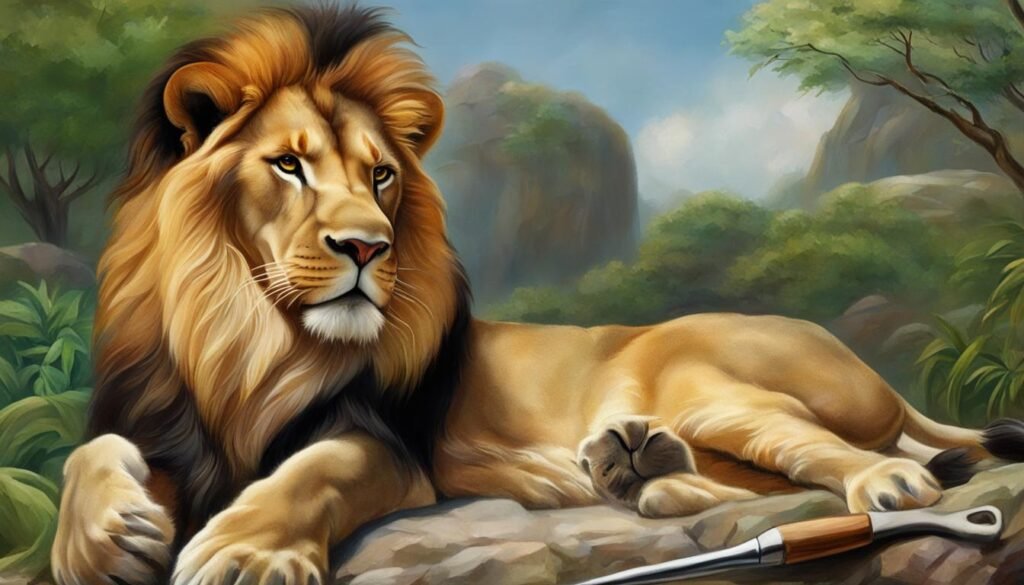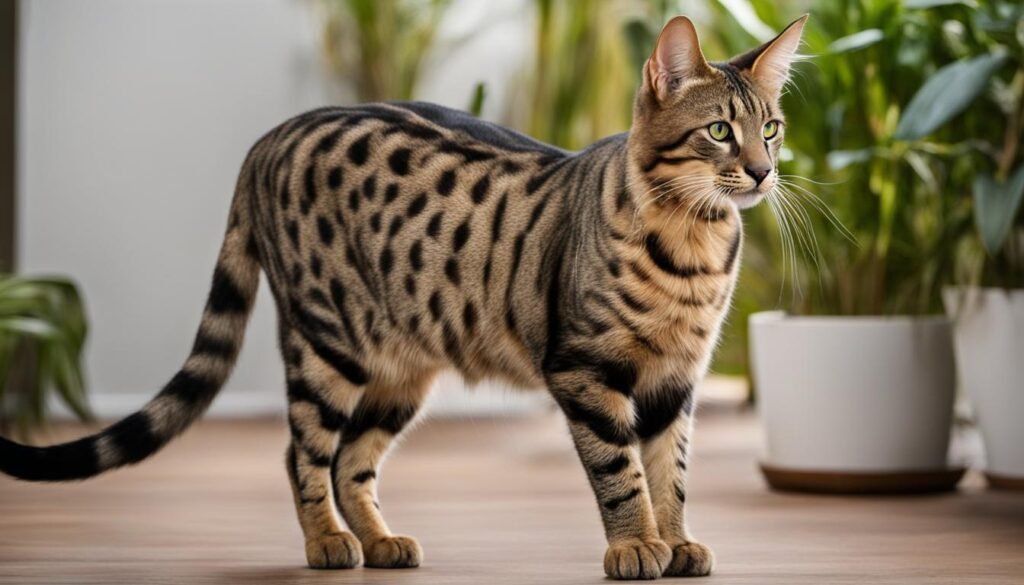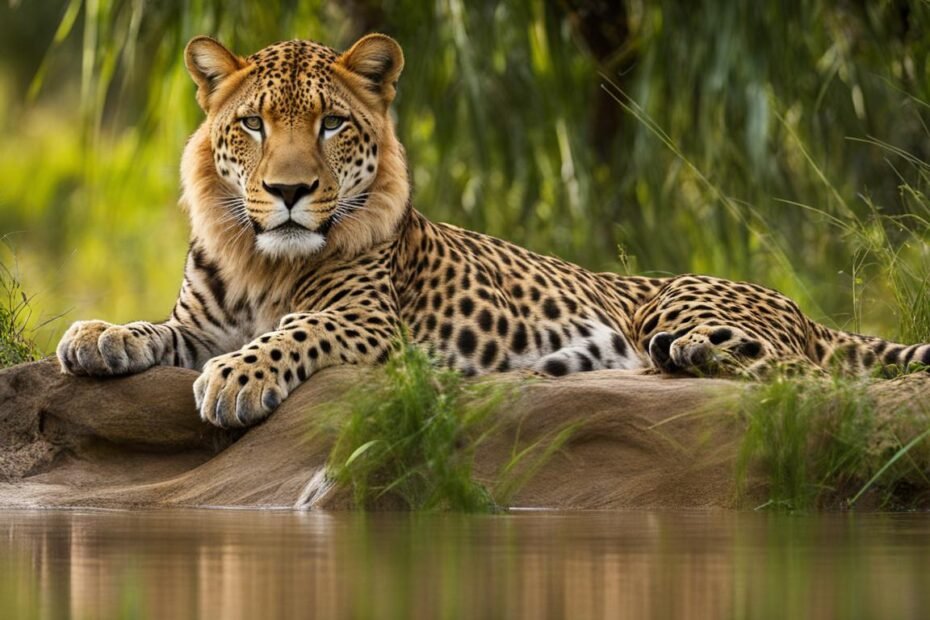Big cat breeds may not be as well-known as their smaller counterparts, but they certainly make a big impression. From the elegant Maine Coon to the energetic Bengal, these larger feline friends have unique traits and fascinating histories. In this guide, we will explore the world of big cat breeds, discussing their size, appearance, and suitability as pets.
Key Takeaways:
- Big cat breeds offer a unique and captivating pet ownership experience.
- They come in a variety of sizes and have distinct physical characteristics.
- Big cat breeds have a long history of domestication and make great companions.
- Caring for big cat breeds requires special attention to grooming and exercise.
- When choosing a big cat breed, consider your lifestyle and preferences.
Understanding Big Cat Breeds: Size and Characteristics
Big cat breeds are known for their impressive size and unique physical characteristics. These oversized feline companions make a striking presence in any home. Let’s explore some of the largest domestic cats and their distinguishing traits.
Maine Coon
The Maine Coon is one of the largest domestic cat breeds, weighing up to 20 pounds. With their muscular build and long, bushy tails, they exude elegance and grace. Known for their friendly and social nature, Maine Coons are often considered gentle giants.
Bengal
The Bengal breed is renowned for its striking coat patterns that resemble those of their wild ancestors. Large and muscular, Bengal cats have a playful and energetic personality. They require plenty of mental and physical stimulation to meet their high energy levels.
Ragdoll
Ragdolls are named for their tendency to go limp when picked up, making them highly lovable and easy to handle. These gentle giants have semi-long hair and captivating blue eyes. Ragdolls are known for their calm and affectionate nature, making them ideal companions for families.
British Shorthair
The British Shorthair is a robust and stocky breed with a dense plush coat. Known for their calm temperament, these cats are perfect for families with children. British Shorthairs are patient and gentle, making them excellent companions for both kids and adults.
| Big Cat Breed | Size | Physical Characteristics | Temperament |
|---|---|---|---|
| Maine Coon | Up to 20 pounds | Large, muscular build; long, bushy tail | Friendly, social |
| Bengal | Up to 15 pounds | Striking coat patterns; muscular build | Playful, energetic |
| Ragdoll | Up to 20 pounds | Semi-long hair; captivating blue eyes | Calm, affectionate |
| British Shorthair | Up to 17 pounds | Robust, stocky build; dense plush coat | Calm, patient |
These big cat breeds offer a unique combination of size, appearance, and temperament. Whether you’re seeking a friendly and sociable companion or a playful and energetic feline, there is a big cat breed that will suit your preferences. Remember to consider factors such as grooming needs, activity levels, and compatibility with children and other pets when choosing the perfect oversized feline friend for your home.
The History of Big Cat Breeds
Big cat breeds, despite their size, have a rich history of domestication. Cats have been living alongside humans for thousands of years, and their journey from wild predators to beloved pets is a fascinating one. The process of domestication has allowed these majestic felines to develop affectionate and adaptable personalities, making them suitable companions for families and individuals alike.
Throughout history, cats were valued for their hunting skills and ability to control rodent populations. Ancient civilizations, such as the Egyptians, revered cats and even worshipped them as deities. As humans began to establish permanent settlements and store food supplies, cats became indispensable for keeping vermin at bay.
“The cat could very well be man’s best friend but would never stoop to admitting it.”
— Doug Larson
Over time, cats started to form close bonds with humans, leading to the development of more intimate relationships. The gradual transition from wild to domesticated cats involved selective breeding to highlight desirable traits, such as docility and sociability. This process resulted in the emergence of various cat breeds, including the large and impressive big cat breeds we know today.
The Role of Big Cats as Pets
Big cats, although they still possess some of their wild instincts, have adapted to a life alongside humans. Domestication has shaped their behavior and temperament, making them suitable for companionship. Big cat breeds, like the Maine Coon and British Shorthair, are known for their gentle and affectionate nature, making them ideal pets for families. Their size may be imposing, but their personalities are often gentle and loving.
As pets, big cat breeds thrive on human interaction and attention. They form strong bonds with their human companions and enjoy being part of the family. While they may require more space and resources compared to smaller cats, the rewards of owning a big cat breed are immeasurable.
Popular Big Cat Breeds for Families
When it comes to choosing a big cat breed for your family, there are several options that are known for their gentle and friendly nature. These large cat breeds not only get along well with children, but they also tend to be sociable and adaptable to various household environments.
One popular choice for families is the British Shorthair. Known for their calm and affectionate temperament, British Shorthairs are patient with children and often enjoy being part of the family activities. Their easy-going nature makes them a great choice for families looking for a big cat breed that can handle the energy and playfulness of kids.
Another big cat breed that is well-suited for families is the Maine Coon. These gentle giants are known for their friendly and sociable personalities. Maine Coons are often described as “dog-like” in their behavior, as they enjoy being around people and are known to get along well with other pets in the household. Their large size and playful nature make them a great companion for children.
Overall, when considering a big cat breed for your family, it’s important to choose one that matches your lifestyle and preferences. Whether you opt for the calm and affectionate British Shorthair or the friendly and sociable Maine Coon, both breeds can provide years of joy and companionship as family pets.
Caring for Big Cat Breeds
When it comes to caring for big cat breeds, there are a few important considerations to keep in mind. These majestic feline friends have unique needs due to their size and specific breed characteristics. From grooming to exercise, providing proper care will help ensure their health and happiness.
Grooming
Big cat breeds often have long, dense coats that require regular grooming to keep them clean and free from tangles. Brushing their fur at least once a week will help prevent matting and remove loose hair. Additionally, these breeds may benefit from occasional bathing to keep their coats in top condition. It’s important to use cat-specific grooming tools and products to avoid skin irritation. Regular grooming sessions not only help maintain their appearance but also promote bonding between you and your furry companion.
Exercise and Mental Stimulation
Due to their larger size and often higher energy levels, big cat breeds may require more exercise and mental stimulation compared to smaller cats. Providing them with plenty of opportunities to play, climb, and explore is essential for their overall well-being. Interactive toys, scratching posts, and cat trees are great additions to their environment. Additionally, engaging in play sessions with your big cat breed will not only help keep them physically active but also strengthen the bond between you and your feline friend.
| Exercise Tips for Big Cat Breeds | Benefits |
|---|---|
| Create an indoor obstacle course | Enhances agility and mental stimulation |
| Use puzzle toys and treat-dispensing devices | Keeps your big cat mentally engaged and prevents boredom |
| Provide access to vertical spaces | Allows them to satisfy their natural instinct to climb |
Quote: “Regular grooming sessions not only help maintain their appearance but also promote bonding between you and your furry companion.” – Pet Grooming Expert
Remember to consult with your veterinarian to ensure you are meeting all the specific needs of your big cat breed. Your veterinarian can provide guidance on diet, exercise, and any breed-specific health concerns that may require additional attention. By providing proper care and attention, you can enjoy a happy and healthy life with your big cat breed.

Choosing the Right Big Cat Breed for You
When it comes to choosing a big cat breed as a pet, there are several factors to consider to ensure a good fit for your lifestyle and preferences. Each breed has its own unique characteristics and temperament, so thorough research is essential to make an informed decision.
Temperament
The temperament of a big cat breed is an important consideration. Some breeds, like the Bengal or Savannah, are known for their high energy levels and need plenty of mental and physical stimulation. These breeds thrive in active households and require ample space to play and explore. On the other hand, breeds like the Maine Coon or Ragdoll are known for their calm and laid-back personalities, making them well-suited for quieter households.
Grooming Needs
Big cat breeds may have different grooming requirements compared to smaller cats. Some breeds, like the Maine Coon and Persian, have long, dense coats that require regular brushing to prevent matting and keep them looking their best. Other breeds, like the Sphynx or Peterbald, are hairless and require minimal grooming. Consider your willingness and ability to commit to regular grooming before choosing a breed.
Activity Levels
Consider the activity level of a big cat breed and how it aligns with your lifestyle. Some breeds, such as the Bengal or Abyssinian, are highly active and require plenty of mental and physical stimulation to keep them entertained. These breeds are best suited for owners who can provide ample playtime and environmental enrichment. If you prefer a more low-key companion, breeds like the British Shorthair or Scottish Fold may be a better fit, as they tend to be less active.
By taking into account the temperament, grooming needs, and activity level of different big cat breeds, you can make an informed decision and find a furry feline friend that is the perfect match for you and your family.
Big Cat Breeds for Special Considerations
When considering big cat breeds as pets, it’s important to keep in mind some special considerations that may apply to certain breeds. These considerations can range from specific care needs to potential health issues that may be more common in larger cats. By being aware of these factors, you can make an informed decision and ensure the well-being of your feline friend.
Special Care for Hairless Breeds

One example of a big cat breed with special care needs is the Sphynx. Known for their hairless coats, Sphynx cats require extra attention to protect their sensitive skin. Regular bathing is necessary to remove oils and prevent skin irritations. Additionally, they may need to be kept in a warmer environment due to their lack of fur insulation. It’s important to consult with a veterinarian familiar with hairless breeds for guidance on proper care.
Potential Health Issues in Larger Breeds
Another consideration for big cat breeds is the potential for certain health issues. Due to their size, some breeds may be prone to specific conditions. For example, Maine Coons, being one of the largest domestic cat breeds, have a higher risk of developing heart disease and hip dysplasia. Regular veterinary check-ups and screenings can help detect and manage these conditions early on, ensuring your cat’s well-being.
| Big Cat Breed | Potential Health Issues |
|---|---|
| Maine Coon | Heart disease, hip dysplasia |
| Bengal | Patellar luxation, hypertrophic cardiomyopathy |
| Ragdoll | Polycystic kidney disease, bladder stones |
It’s important to note that not every cat in these breeds will develop these health issues, but being aware of the potential risks allows for proactive care and early intervention when needed.
By considering these special considerations for big cat breeds and seeking guidance from professionals, you can provide the best care for your furry companion. Whether it’s adapting to the unique needs of a hairless breed or staying vigilant about potential health issues, your commitment to their well-being will ensure a happy and healthy life for your big cat.
Similarities and Differences Among Big Cat Breeds
Big cat breeds may share the common trait of being larger in size than average domestic cats, but they also possess unique characteristics that set them apart. Understanding these similarities and differences can help you choose the perfect feline companion for your home.
Physical Characteristics
One key aspect that distinguishes big cat breeds is their physical appearance. Some breeds, such as the Maine Coon and Norwegian Forest Cat, have long, thick coats that provide them with extra warmth and protection. On the other hand, breeds like the Bengal and Savannah have striking coat patterns reminiscent of their wild ancestors, making them visually captivating.
Additionally, big cat breeds can vary in terms of size and weight. The Maine Coon, for example, is one of the largest domestic cat breeds and can reach up to 20 pounds, while the Bengal is known for its muscular build and sleek physique.
Temperament and Personality
Big cat breeds also exhibit distinct temperaments and personalities. Some breeds, like the Maine Coon and Ragdoll, are known for their laid-back and gentle nature, making them ideal companions for individuals seeking a calm and affectionate feline friend.
On the other hand, breeds such as the Bengal and Savannah tend to be more active and energetic, requiring plenty of mental and physical stimulation. These breeds thrive in an environment that challenges their agility and intelligence, making them a great choice for owners who are looking for an engaging and interactive pet.
Adaptability and Compatibility
While big cat breeds have their unique traits, they all share a common adaptability to domestic life. Despite their larger size, these feline companions have been successfully domesticated over the years, allowing them to form strong bonds with their human families.
When it comes to compatibility with other pets, big cat breeds generally get along well with other animals when properly introduced and socialized. However, it’s important to consider the individual personality of each cat and monitor their interactions to ensure a harmonious household.
By understanding the similarities and differences among big cat breeds, you can make an informed decision when choosing the best furry companion for your home. Whether you prefer a gentle and laid-back breed or an active and adventurous one, there is a big cat breed that will suit your preferences and provide you with years of love and companionship.
Conclusion
Big cat breeds have established themselves as unique and captivating companions for cat lovers. With their impressive size and individual personalities, these feline giants offer a one-of-a-kind pet ownership experience. Whether you’re seeking a playful and active breed or a gentle and affectionate companion, there is a big cat breed out there that is perfect for you.
Caring for big cat breeds requires special attention due to their size and specific breed characteristics. From regular grooming to providing ample exercise and mental stimulation, meeting their unique needs ensures a happy and healthy life for these furry feline friends.
In summary, this guide has provided a comprehensive overview of big cat breeds, their history, characteristics, and considerations. Armed with this knowledge, you can confidently choose the right big cat breed that aligns with your lifestyle and preferences. Embrace the joy and companionship that these majestic felines bring into your home, and embark on a remarkable journey with your new furry friend.
FAQ
What are some popular big cat breeds?
Popular big cat breeds include Maine Coon, Bengal, Ragdoll, and British Shorthair.
Are big cat breeds suitable as pets for families?
Yes, some big cat breeds, such as the British Shorthair and Maine Coon, are known for their calm and affectionate nature, making them great choices for families.
Do big cat breeds have specific care requirements?
Yes, big cat breeds may require regular grooming, more exercise, and mental stimulation compared to smaller cats. Providing toys, scratching posts, and opportunities to climb can help fulfill their natural instincts.
How should I choose the right big cat breed for me?
It’s important to research each breed’s temperament, grooming needs, and activity levels to align with your lifestyle and preferences.
Are there any special considerations for big cat breeds?
Yes, some big cat breeds may have specific considerations. For example, the Sphynx breed is hairless and requires special care to protect its sensitive skin. It’s important to consult with a veterinarian and do thorough research before bringing home a big cat breed.
What are the unique characteristics of big cat breeds?
Big cat breeds have unique physical characteristics, such as long, dense coats or striking coat patterns. Some have long, thick coats like the Maine Coon and Norwegian Forest Cat, while others have wild-inspired coat patterns like the Bengal and Savannah.
